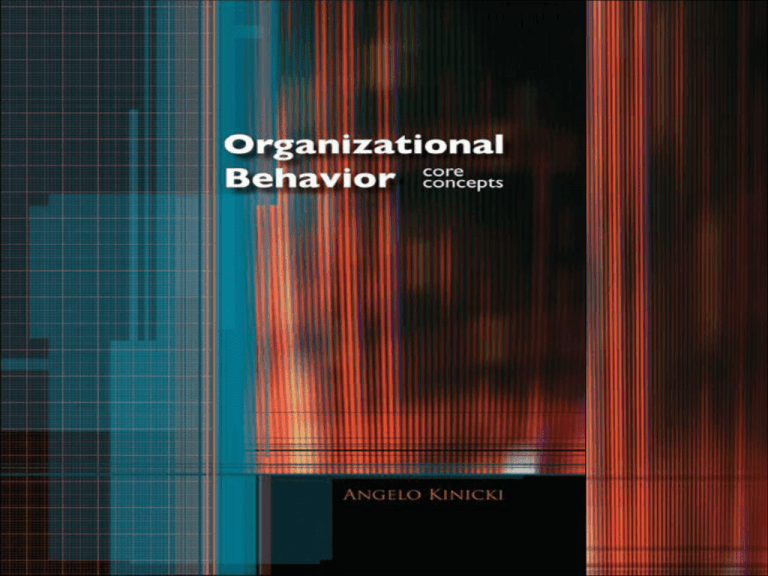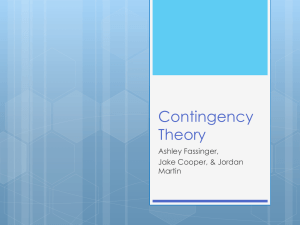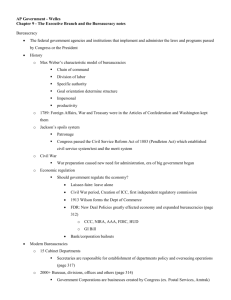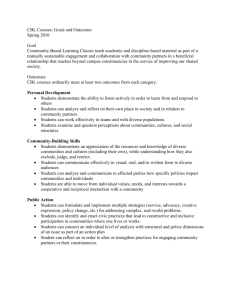
Organizational Behavior
13
core concepts
Organizational Design: How
a Structure Connects
Employees and Tasks
13-2
McGraw-Hill/Irwin
Organizational Behavior, Core Concepts
Copyright © 2008 by the McGraw-Hill Companies, Inc. All rights reserved.
Learning Objectives
• Define organizations and their basic
dimensions
• Explain commonly used metaphors for
organizations as closed or open systems,
military/mechanical bureaucracies, and
biological and cognitive systems
• Describe basic criteria for organizational
effectiveness
13-3
Learning Objectives
• Summarize what is involved in the
contingency approach to organizational
design
• Discuss new-style and old-style
organizations, including virtual
organizations
13-4
What is an Organization?
• Organization
– system of consciously coordinated activities
of two or more people.
13-5
What is an Organization?
• Four common denominators
– Coordination of effort
– Common goal
– Division of labor
– Hierarchy of authority
13-6
Designing Effective Teams
See an article from
Administrative
Science Quarterly
on designing
effective teams
13-7
What is an Organization?
• Unity of command principle
– each employee should report to a single
manager.
13-8
Organization Charts
• Organization chart
– boxes-and-lines illustration showing chain of
formal authority and division of labor.
13-9
Sample Organization Chart for a
Hospital
13-10
Figure 13-1
Organization Charts
• Hierarchy of authority
• Division of labor
• Span of control
– the number of people reporting directly to a
given manager
• Line and staff positions
13-11
Line and Staff Positions
• Staff personnel
– provide research, advice, and
recommendations to line managers.
• Line Managers
– have authority to make organizational
decisions.
13-12
Needed: Open-System Thinking
• Closed System
– self-sufficient entity, closed to the
surrounding environment.
• Open System
– organism that must constantly interact with
its environment to survive
13-13
Organizations as
Military/Mechanical Bureaucracies
• Bureaucracy
– Max Weber’s idea of the most rationally
efficient form of organization
• Weber’s Bureaucracy
– Division of labor
– A hierarchy of authority
– A framework of rules
– Administrative personality
13-14
Organizations as
Biological Systems
• The complex organization is a set of
interdependent parts which together
make up a whole because each
contributes something and receives
something from the whole, which in turn
is interdependent with some larger
environment
13-15
The Organization as an Open
System: The Biological Model
13-16
Figure 13-2
Organizations as Cognitive Systems
• Organizations have mechanisms to
interpret ambiguous events and to
provide meaning and direction for
participants
13-17
Question?
Which effectiveness criteria is the most
widely used?
A. Goal accomplishment
B. Resource acquisition
C. Internal processes
D. Strategic constituencies satisfaction
13-18
Generic Effectiveness Criteria
• Goal accomplishment
– most widely used effectiveness criteria,
measured by comparing key organizational
results with previously stated goals
• Resource acquisition
– organization is effective if it acquires
necessary factors of production
13-19
Generic Effectiveness Criteria
• Internal processes
– healthy system if information flows smoothly
and if employee loyalty, commitment, job
satisfaction prevail
• Strategic constituencies satisfaction
– Strategic constituency: any group of
people with a stake in the organization’s
operation or success.
13-20
Mixing Effectiveness Criteria:
Practical Guidelines
• Goal accomplishment
– approach is appropriate when goals are
clear, consensual, time-bounded, and
measurable
• Resource acquisition
– approach is appropriate when inputs have a
traceable effect on results or output
13-21
Mixing Effectiveness Criteria:
Practical Guidelines
• Internal processes
– appropriate when organizational
performance is strongly influenced by
specific processes
• Strategic constituencies
– appropriate when powerful stakeholders can
significantly benefit or harm the organization
13-22
The Contingency Approach to
Designing Organizations
• Contingency approach to organization
design
– creating an effective organizationenvironment fit.
13-23
Mechanistic versus Organic
Organizations
• Mechanistic organizations
– Rigid bureaucracies with strict rules,
narrowly defined tasks, and top-down
communication.
• Organic organizations
– Flexible networks of multitalented individuals
who perform a variety of tasks
13-24
Question?
In what type of decision making do top
managers make all key decisions?
A. Centralized
B. Decentralized
C. Fundamental
D. Primary
13-25
Approaches to Decision Making
• Centralized decision making
– top managers make all key decisions
• Decentralized decision making
– lower-level managers are empowered to
make important decisions
13-26
New-Style versus Old-Style
Organizations
13-27
Table 13-1
Virtual Organizations
• Virtual Organizations
– modern information technology allows
people to get something accomplished
despite being geographically dispersed
13-28






